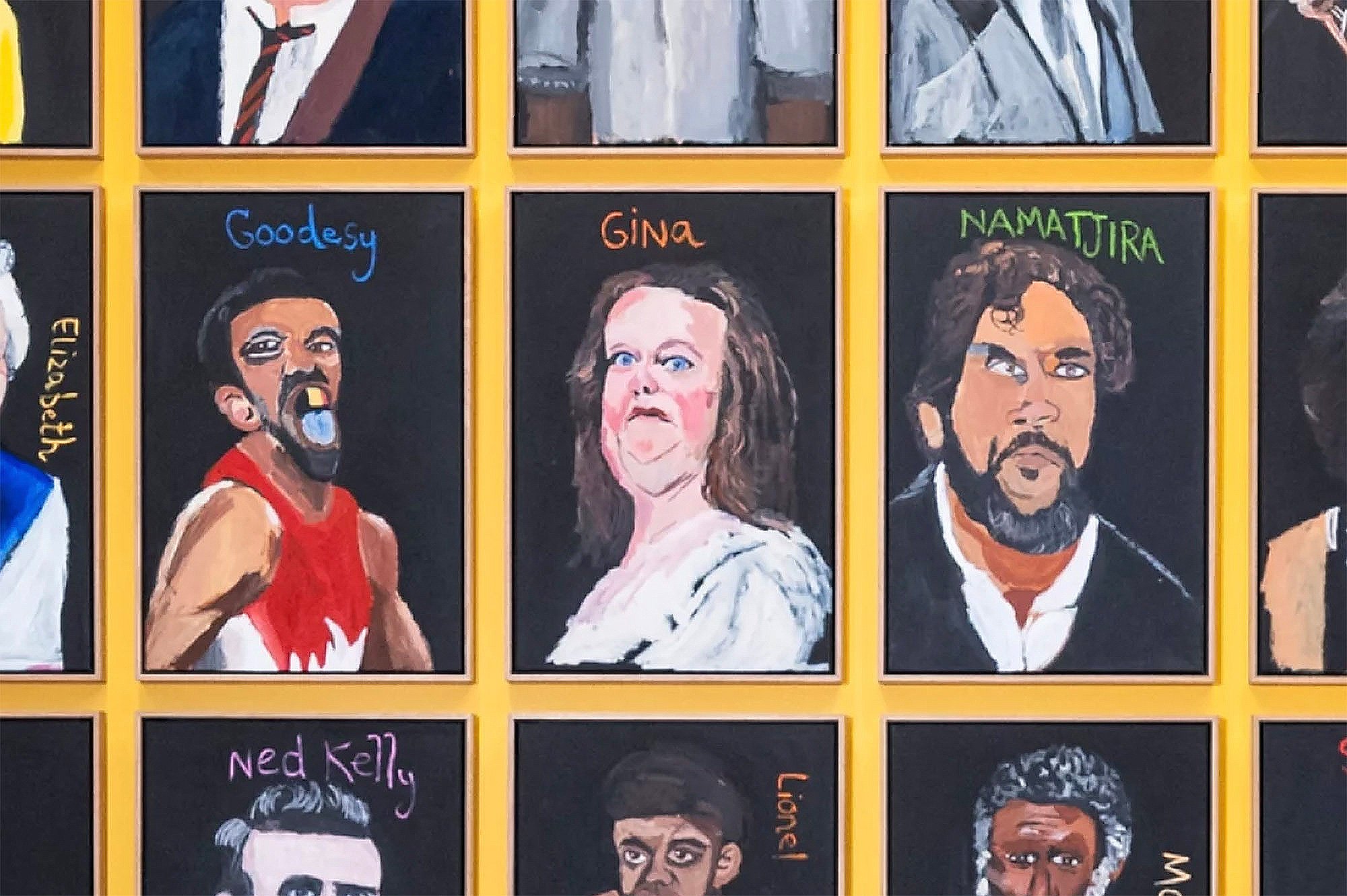
Australia’s richest woman is apparently hopping mad at a portrait of her now on view at Canberra’s National Gallery of Australia. She wants the painting, by the indigenous Western Aranda artist Vincent Namatjira, removed from view in the exhibition “Vincent Namatjira: Australia in Colour.”
The museum is standing firm in support of the artist and in defense of its right to display the canvas.
“Since 1973, when the National Gallery acquired Jackson Pollock’s Blue Poles, there has been a dynamic discussion on the artistic merits of works in the national collection, and/or on display at the gallery,” the museum said in a statement shared with Artnet News. “We present works of art to the Australian public to inspire people to explore, experience, and learn about art.”
Installation view of “Vincent Namatjira: Australia in colour at the National Gallery of Australia, Kamberri/Canberra, 2024. Photo courtesy of the National Gallery of Australia.
Rinehart did not immediately respond to a request for comment, emailed to her in care of her company Hancock Prospecting, a mining and agricultural firm. The museum’s website shows that she is a friend of the museum and has made a gift between $4,999 and $9,999 ($3,338 to $6,679 in U.S. dollars).
“I paint the world as I see it,” Namatjira wrote in a statement on Thursday, quoted in the Guardian. “People don’t have to like my paintings, but I hope they take the time to look and think, ‘Why has this Aboriginal bloke painted these powerful people? What is he trying to say?’” He paints significant people who have impacted society for better or worse, he said. “Some people might not like it, other people might find it funny but I hope people look beneath the surface and see the serious side too.”
Gina Rinehart in Sydney, Australia, 2015. Photo: Matt King/Getty Images.
It’s true that Rinehart doesn’t look so great in the portrait, which gives her a very prominent double chin and staring eyes that make her look a bit unhinged. All the same, there was no fuss when the painting hung at Adelaide’s Art Gallery of South Australia, where it was on show for several months, ending in January.
Namatjira has portrayed Rinehart before. His 2017 painting Gina Rinehart and Me shows the two shoulder-to-shoulder, neither looking too pleased with the arrangement. The Richest (Gina Rinehart), from 2016, earned him a finalist spot for the $100,000 Ramsay Art Prize the following year.
“I like to paint with a little bit of humor,” the artist said about Gina Rinehart and me II, in the collection of the Art Gallery of Western Australia (in which both look a bit happier). “Humor takes away some of their power and keeps us all equal.”
Also coming in for the Namatjira treatment in the current exhibition are an international host of famous figures past and present, from Queen Elizabeth II (who exhibits a strange grimace) to Australian rules footballer Adam Goodes to musician Jimi Hendrix.
The museum describes the artist, from Indulkana in South Australia, as “a satirical chronicler of Australian identity.” He has been painting portraits of significant figures since 2013 and has won considerable attention: in 2020, he became the first Indigenous artist to win the Archibald Prize, granted by the Art Gallery of New South Wales, for his portrait of Goodes, and was decorated with the Medal of the Order of Australia (OAM) for his contribution to Indigenous visual arts.
Vincent Namatjira at the National Gallery of Australia, Kamberri/Canberra, 2024. Photo courtesy of the National Gallery of Australia.
Namatjira, a native of Alice Springs, was torn from his family at age six and raised in foster care in distant Perth, where he was deprived of all contact with and knowledge of his relatives.
“I was just taken away by strangers,” he said in a video on the museum’s website. “I lost connection with family, Country, and culture. That was a bit hard.
“That’s why I paint the politicians and people with tuxedos and suits, that’s what the politician was to me and my sister—’We raise you until you’re 18, you can go back to family, pushed out the door and sent back on a plane to Alice Springs.’”
“They don’t apologize at all. We never got a ‘see you’ or ‘good bye’ or ‘take care,’ that kind of thing.”
Also on view is a selection of works, curated by the artist, by his great-grandfather, famed artist Albert Namatjira, whom he cited as his “number one key role model.” He had no knowledge of his connection to the elder artist until he was an adult, and was amazed to discover that he was part of an artistic lineage.
“I believe in the power of art, the power of the paintbrush,” said Namatjira. “I know that art can change lives—it changed mine—and I hope that art can change the world too.”